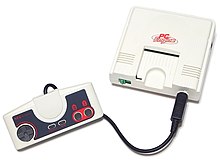PC Engine
| PC Engine | |
 | |
| Grundinformation | |
|---|---|
| Tillverkare | NEC Corporation |
| Typ | Stationär konsol |
| Generation | fjärde generationens konsoler |
| Lansering | |
| Hårdvara | |
| Media | HuCard minneskort |
| Övrigt | |
| Efterträdare | PC-FX |
PC Engine(japanska: PCエンジン?, PC Enjin), i USA: Turbografx-16, var en spelkonsol ifrån NEC Corporation och Hudson Soft som släpptes i Japan, USA, Frankrike och Sydkorea. En av NEC PAL-anpassad version av den amerikanska Turbografx-16 släpptes 1990 i en mindre serie på den europeiska marknaden under namnet Turbografx (utan tillägget 16). Dessa såldes främst i Storbritannien och Spanien, men även i länder som Portugal och Nederländerna. Konsolen var ett hybridsystem: den hade en 8-bitars processor men en 16-bitars grafikprocessor. PC Engine hade både konkurrenskraftig hård- och mjukvara, men den kunde inte stå sig mot SNES och Mega Drive och hamnade således på tredje plats.
Historia
I mitten på 80-talet gick NEC Corporation och Hudson Soft ihop och utvecklade PC Engine som senare släpptes 1987. Under konsolens livstid släpptes 15 varianter, bland annat en CD-ROM-expansion och portabla system.
CD-ROM²
En av de viktigaste tillbehören till PC Engine var CD-ROM², en CD-ROM-expansion som släpptes 1988. Denna expansion släpptes även senare sammanslagen med en PC Engine under namnet PC Engine Duo 1991.
- PC-Engine CoreGrafx CD-ROM².
- TurboGrafx-16 CD-ROM².
- SuperGrafx Super-CD-ROM².
- PC Engine Super-CD-ROM².
- PC-Engine-Duo.
- PC-Engine-Duo-RX.
HuCard
PC Engine använde inte spelkassetter som sina konkurrenter, utan använde istället ett minneskort kallat HuCard, utvecklat av Hudson Soft.
Hårdvara
- CPU: 8-bitars Hudson Soft HuC6280A @ 1,79 MHz eller 7,16 MHz
- RAM: 8 KiB
- VRAM: 64 KiB
- Upplösning: 512 × 242 (max), 256 × 240 (vanligast)
- Färgdjup: 9 bitar, 512 färger tillgängliga, 482 på skärmen samtidigt
- Spritar: 64 samtidigt
- Ljud: 6 kanaler
Spel
PC engine är känd bland annat för sina shoot 'em up, ursprungstrogna arkad-konverteringar. Systemet har även ett antal spel som är legendariskt svåra att få tag på, till exempel Darius Alpha som kan kosta över 1 000 amerikanska dollar.[2]
Toppspel:
- Gate of Thunder
- Castlevania: Rondo of Blood
Se även
Källor
Noter
- ^ La Bible PC Engine, volume 1 (Éd. Pix'n Love, février 2009, p. 35)
- ^ The Rarest & Most Valuable PC Engine/TurboGrafx 16 Games
Externa länkar
Media som används på denna webbplats
The Flag of Europe is the flag and emblem of the European Union (EU) and Council of Europe (CoE). It consists of a circle of 12 golden (yellow) stars on a blue background. It was created in 1955 by the CoE and adopted by the EU, then the European Communities, in the 1980s.
The CoE and EU are distinct in membership and nature. The CoE is a 47-member international organisation dealing with human rights and rule of law, while the EU is a quasi-federal union of 27 states focused on economic integration and political cooperation. Today, the flag is mostly associated with the latter.
It was the intention of the CoE that the flag should come to represent Europe as a whole, and since its adoption the membership of the CoE covers nearly the entire continent. This is why the EU adopted the same flag. The flag has been used to represent Europe in sporting events and as a pro-democracy banner outside the Union.Författare/Upphovsman: Muband, Licens: CC BY-SA 3.0
PC Engine (PI-TG001) with controller (PI-PD001).
(c) VIC på japanska Wikipedia, CC BY 3.0
The NEC PC Engine Duo. A video game console only released in Japan in 1991.
(c) VIC på japanska Wikipedia, CC BY 3.0
The NEC PC Engine Duo. A video game console only released in Japan in 1994.
Författare/Upphovsman: PiaCarrot, Licens: CC BY-SA 3.0
PC Engine First Model (attached Super CD-ROM2)
Författare/Upphovsman: PiaCarrot, Licens: CC BY-SA 3.0
PC Engine Super Grafx (attached Super CD-ROM2)
The North America TurboGrafx 16 with CD unit attached. The first console to have a CD-ROM attachment/capability, the unit came with a dock and a detachable CD-ROM drive.
(c) SACHEN på japanska Wikipedia, CC BY 3.0
NECホームエレクトロニクス、PC Engine CD-ROM2 Interface Unit
















